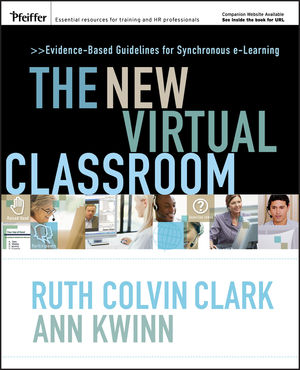The New Virtual Classroom: Evidence-based Guidelines for Synchronous e-LearningISBN: 978-0-7879-8652-0
Hardcover
304 pages
April 2007, Pfeiffer
 This title is out-of-print and not currently available for purchase from this site.
|
Contents of the CD-ROM ix
Preface xi
Acknowledgments xiii
Book Overview xv
INTRODUCTION 1
1. Meet the New Virtual Classroom 3
PART ONE: LEARNING AND THE NEW VIRTUAL CLASSROOM 25
2. Learning in the New Virtual Classroom 27
3. Features to Exploit in the New Virtual Classroom 45
4. Teaching Content Types in the New Virtual Classroom 69
PART TWO: ENGAGING PARTICIPANTS IN THE NEW VIRTUAL CLASSROOM 85
5. Visualize Your Message 87
6. Make It Active: Planning Interactions in the New Virtual Classroom 107
7. Make It Active: Maximizing Engagement in the New Virtual Classroom 129
PART THREE: OPTIMIZING YOUR VIRTUAL EVENTS 145
8. Manage Mental Load in the New Virtual Classroom 147
9. Make a Good First Impression 167
10. Packaging Your Virtual Classroom Session 183
11. Problem-Based Learning in the New Virtual Classroom 205
PART FOUR: CREATING EFFECTIVE LEARNING EVENTS IN THE NEW VIRTUAL CLASSROOM 229
12. Getting Started in the New Virtual Classroom 231
Glossary 249
References 263
About the Authors 269
Index 271
How to Use the CD-Rom 279
Pfeiffer Publications Guide 281
Contents of the CD - ROM
Virtual Classroom Lessons
• How to Construct a Formula in Excel
• How to Define Business Goals
• How to Plan an Interview
VC Planning and Support Documents
• Virtual Classroom Readiness Checklist
• Virtual Classroom Lesson Inventory and Script
• Virtual Classroom Welcome Letter
Designers and facilitators new to the virtual classroom often want to see good examples. This book’s companion CD contains a variety of sample lessons that should give you a good feel for the virtual classroom in general and give you realistic examples of the techniques discussed in the book. If you are involved developing or delivering procedural training, such as for using soft- ware, we recommend viewing the How to Use Formulas in Excel lesson. A more principle-based or less step-by-step type of task is taught in the Defining Business Goals lesson, and the Planning an Interview lesson rethinks the same content in a problem-based structure, which you may find interesting if you want to see the difference between this and the more standard directive architecture.
You can access the samples as they are mentioned in the book, especially at the end of each chapter as you reach the On The New Virtual Classroom CD section, or you can “go to the movies” after reading a few chapters when you want a break. Or, you can leave the CD in its envelope for a while until you want some inspiration for designing your next virtual class. You may even simply enjoy seeing a virtual classroom tool that is different from your own. We have used Elluminate. Instructors can show portions of these demonstrations in either a face-to-face or virtual class.
The CD also contains Virtual Classroom Planning and Support Documents that you can use in designing and implementing your synchronous courses. The Virtual Classroom Readiness Checklist helps you to decide if the course you have in mind is appropriate for the virtual classroom and gives some of the factors that recommend the virtual classroom as a delivery media plus the elements of a synchronous-friendly organization. Once you have made the decision to move forward with this type of delivery, you can use the Virtual Classroom Lesson Inventory and Script to plan and lead your session. Finally, a sample Welcome Letter is included that you can adapt and distribute to your students to make sure they are ready for the great instruction you have prepared for them.



